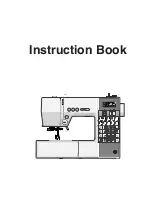
GETTING READY
———————————————————————————————————————————————————————————————————————————————————————————————————————
24
h
Attach zigzag foot “J”.
• For details on changing the presser foot, refer
to “Replacing the presser foot” (page 29).
i
Turn on the sewing machine.
X
The LCD comes on.
j
Select a stitch.
• For details on selecting a stitch, refer to
“Selecting a stitch” (page 38).
• For details on the stitches that can be sewn
with the twin needle, refer to “Stitch
settings” (page 85).
k
Press
(Needle mode selection key).
X
The twin needle can now be used.
• To return to single needle sewing, press
(Needle mode selection key).
• Even after the sewing machine is turned off,
the twin needle setting is not cancelled.
l
Start sewing.
• For details on starting to sew, refer to
“Starting to sew” (page 40).
X
Two lines of stitching are sewn parallel
to each other.
Note
●
When using the twin needle, the stitches
may become bunched together, depending
on the types of thread and fabric that are
used. If this occurs, increase the stitch
length. For details on adjusting the stitch
length, refer to “Adjusting the stitch length
and width” (page 38).
●
When using the twin needle, be sure to attach
zigzag foot “J”, otherwise the needle may
break or the machine may be damaged.
●
After adjusting the stitch width, slowly turn
the handwheel toward you
(counterclockwise) and check that the needle
does not touch the presser foot. If the needle
hits the presser foot, the needle may bend or
break.
●
When using the twin needle, be sure to select
the twin needle setting, otherwise the needle
may break or the machine may be damaged.
CAUTION
CAUTION
CAUTION
●
When changing the sewing direction, press
(needle position button) to raise the
needle from the fabric, and then raise the
presser foot lever and turn the fabric.
Otherwise the needle may break or the
machine may be damaged.
●
Do not try turning the fabric with the twin
needle left down in the fabric, otherwise the
needle may break or the machine may be
damaged.
CAUTION
















































